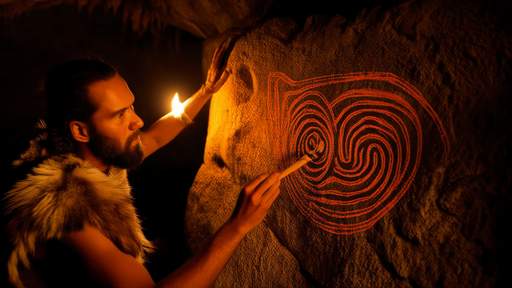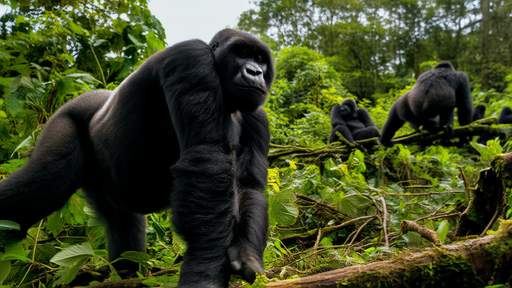In the intricate tapestry of human history and scientific discovery, recent findings have illuminated both the distant past and the far reaches of the cosmos. From the ancient rituals of Jerusalem to the mysteries of Earth's core and the enigmatic signals from space, these discoveries are reshaping our understanding of the world and beyond.
Jerusalem's Hidden Treasures
For centuries, historians and archaeologists have puzzled over a significant gap in Jerusalem's historical record. The Early Hellenistic Period, spanning from 332 to 141 BC, was a time of profound cultural and political transformation, yet tangible archaeological evidence from this era has been scarce—until now.
Excavations at the Jerusalem Walls National Park have unearthed remarkable artifacts that are filling in the blanks. Among the most intriguing finds are two child-sized gold rings, each adorned with a gleaming red gemstone. Initially mistaken for modern pieces due to their excellent condition, these 2,300-year-old rings are now believed to have been intentionally buried by young women as part of a coming-of-age ritual before marriage.
These rings, along with other objects such as bronze earrings and a gold earring resembling a horned animal, are providing a more detailed portrait of Jerusalem during the Hellenistic Period. The discovery suggests that the city was a vibrant center of Greek influence, blending cultural traditions and adopting new customs. The rings, in particular, hint at the personal and symbolic significance of such rituals, offering a glimpse into the lives of ordinary people during this transformative era.
Earth's Hidden Riches
While Jerusalem's history is being pieced together through ancient artifacts, a new study is shedding light on the Earth's geological secrets. Researchers have long known that the majority of the planet's gold is trapped within its molten core. However, recent analyses of volcanic rocks from Hawaii suggest that precious metals like gold and platinum are escaping into the mantle and eventually making their way to the surface.
The study, which involved examining volcanic rocks for traces of rare metals, revealed the presence of ruthenium—a silver-gray metal as rare as gold. This finding indicates that these metals, likely abundant in the Earth's early building materials, are migrating from the core to the mantle. As volcanic islands form, these metals are carried to the surface, suggesting that the Earth's crust may continue to receive small but steady infusions of precious metals from its core.
This discovery not only challenges our understanding of the Earth's geological processes but also raises intriguing possibilities about the future availability of precious resources. If the core continues to leak metals, the Earth's crust could be slowly replenishing its supply of gold and platinum, albeit in minuscule amounts.
Starship's Bold Journey
In the realm of space exploration, SpaceX's ambitious Starship program continues to push the boundaries of what is possible. The ninth test flight of Starship, the most powerful rocket ever built, marked a significant milestone with the first reuse of a Super Heavy booster. While the spacecraft achieved greater altitude than in previous tests, it encountered several challenges, including the failure to deploy dummy satellites and reignite its engines in space.
Despite these setbacks, the test flight provided valuable data for future missions. The ability to reuse boosters is a crucial step toward making space travel more sustainable and cost-effective. As SpaceX continues to refine its technology, the lessons learned from each test bring humanity one step closer to the dream of regular and affordable space travel.
Sharks' Unusual Feast
In the natural world, rare and captivating phenomena continue to astonish observers. Off the coast of Hawaii's Big Island, a remarkable event unfolded as at least 12 sharks from two distinct species engaged in a communal feast lasting over eight hours. Typically solitary feeders, these sharks' behavior highlights the complexity and adaptability of marine life.
This unusual social interaction among sharks offers insights into their feeding habits and social structures. Such observations are crucial for understanding the dynamics of marine ecosystems and the roles that top predators play in maintaining ecological balance.
Mysterious Cosmic Signals
In the vast expanse of space, astronomers have detected an enigmatic object emitting flashes of radio waves every 44 minutes. Known as ASKAP J1832-0911, this object is releasing not only radio pulses but also powerful X-rays observed by NASA's Chandra X-ray Observatory. These high-energy X-rays set ASKAP J1832-0911 apart from other cosmic phenomena, marking it as a potential new entry in the class of long-period transients.
"This object is unlike anything we have seen before," said Dr. Andy Wang, an associate lecturer at the Curtin Institute of Radio Astronomy in Australia. The discovery of such a unique object underscores the ongoing mysteries of the universe and the need for continued exploration and research.
Ancient Egypt's Burial Secrets
In Luxor, Egypt, archaeologists have uncovered three tombs in an ancient burial complex known as Dra’ Abu el-Naga. Dating back to the New Kingdom (1539-1077 BC), these tombs were reserved for prominent non-royal individuals. Painted figures, hieroglyphs, and inscriptions found within the tombs have helped researchers identify the names and occupations of those interred there.
These discoveries enrich our understanding of ancient Egyptian society, revealing the lives and status of individuals who lived during this period. The detailed inscriptions and artwork provide a window into the cultural and religious practices of the time, highlighting the importance of burial rituals and the afterlife in ancient Egyptian beliefs.
The Quest for Knowledge Continues
As these discoveries unfold, they underscore the relentless pursuit of knowledge across various fields. From the ancient rituals of Jerusalem to the geological secrets of the Earth's core, from the challenges of space exploration to the mysteries of the cosmos, each new finding brings us closer to understanding the complexities of our world and beyond.
In the realm of science, researchers continue to unravel the mysteries of the universe, from the origins of precious metals to the behavior of celestial objects. In archaeology, each unearthed artifact adds a new layer to the story of human history, revealing the lives and traditions of our ancestors.
As we stand on the brink of new discoveries, the journey of exploration continues. Whether delving into the depths of the Earth, venturing into the cosmos, or uncovering the remnants of ancient civilizations, the quest for knowledge remains a fundamental part of the human experience.

By Daniel Scott/Jun 6, 2025

By John Smith/Jun 6, 2025

By Daniel Scott/Jun 6, 2025

By Emma Thompson/Jun 6, 2025

By Sophia Lewis/Jun 6, 2025

By Olivia Reed/Jun 6, 2025

By Joshua Howard/Jun 6, 2025

By David Anderson/Jun 6, 2025

By Emma Thompson/Jun 6, 2025

By Emily Johnson/Jun 6, 2025

By Samuel Cooper/Jun 6, 2025

By Emily Johnson/Jun 6, 2025

By Sophia Lewis/Jun 6, 2025

By Jessica Lee/Jun 6, 2025